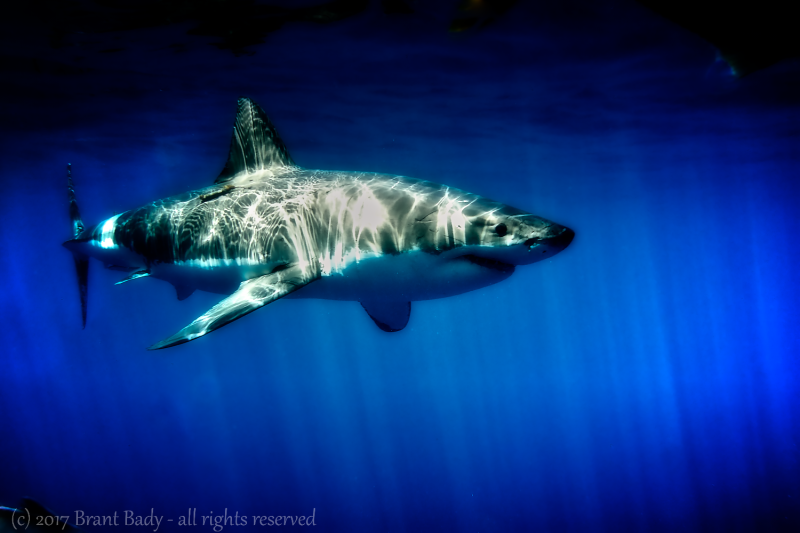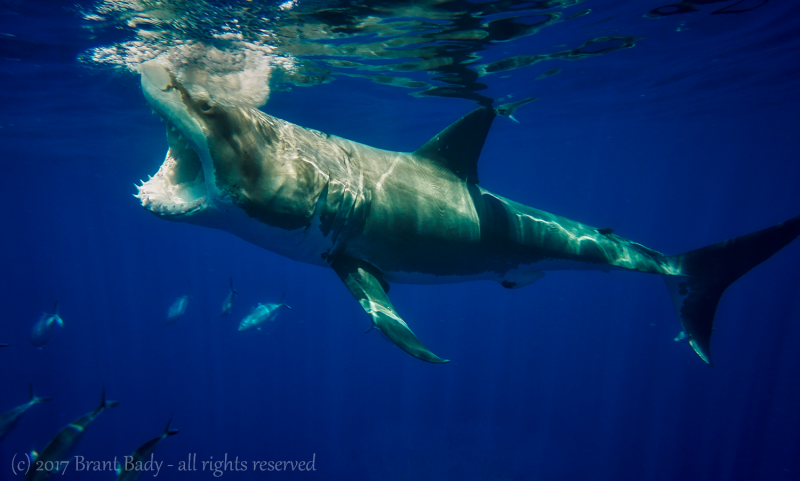
I have been in the water with a variety of shark species around the world (via either scuba or snorkeling), including: harmless Whale sharks in the Philippines, Six Gill sharks in B.C. Canada, Leopard sharks in Thailand, Nurse and Caribbean Reef sharks in Belize, Hammerhead sharks in the Galapagos Islands, and White & Black Tip sharks with even a glimpse of a Thresher shark in the Marshall Islands.
The closest I ever came to any kind of shark induced excitement was having just speared a fish, a hungry and aggressive white tip came torpedoing in and took my fishy dinner right off the end of my spear – damn, no protein for dinner that night, back to eating cabbage (see my post “How I Spent a Month on a Slave Ship in the South-ish Pacific”).
Great White sharks are a different matter, however. While I have dove and swam in waters they are known to inhabit – such as when I was diving in New Zealand (a Great White was in the general area and chasing a few surfers), or when swimming offshore from the Baha Peninsula in the general vicinity of the Island of Guadalupe (one of the best places to study them because of their concentration) – in fact I actually had never seen a Great White shark in person until I went to Australia. Out of sight – out of mind I guess.
Ethics
When I started planning my visit to “Down Under”, the possibility of seeing a Great White in the wild really caught my interest, presuming that I wouldn’t be setting myself up to be a dinner snack on my own. In Southern Australia, near Port Lincoln, it is possible to do an expedition of sorts and go cage diving with Great Whites, where you are inside a sturdy aluminum cage hung over the side of the boat, and wild Great Whites are swimming around on the other side of the aluminum bars. However it is not without controversy, as a few of the tour boats are permitted by the government to use “chum” (a soupy mix of raw fish chunks and blood), to attract the sharks – also called “berleying”. The ethical case against chumming is that its not natural and may therefore alter the behavior of the animals, and may condition them to less hesitant to approach and possibly more inclined attack humans.

My Experience
Shark cage diving is not inexpensive at $500 for the day. Its a long boat trip out to Neptune Rocks where it takes place because these rocks are home to fur seals which are the preferred food for the Great Whites in this area. While the water can be rough on the trip to Neptune Rocks, the day I visited it was a perfect day with nearly flat water and a sunny day to boot. The tour I took was professionally run, the boat was well equipped and outfitted, and the staff both knowledgeable and helpful.
Upon arriving, a huge cage of aluminum bars was lowered by a hydraulic crane off the stern of the boat by the staff. People were divided into appropriate groups, given thick wet-suits with weight belts, and then given a bit of direction about how to breath through the compressed air regulators, and also advised as to what signals would be employed to notify them when it was time to come out. While the staff were quick to point out that a) one didn’t need to be a certified diver to do this, and b) it was perfectly safe, I would dispute that slightly, in that the air regulators provide air under slight pressure more than on the surface. If someone was to lie flat on the bottom of the cage, take a deep breath thereby filling their lungs, and then stand up without exhaling, they could actually cause themselves an air embolism in the lungs, and be in serious trouble. But practically, its a bit unlikely anyone would do that, but its technically possible, and this is one of the main accidents that formal training in SCUBA diving is designed to prevent.
As each group went into the aluminum shark cage, the staff would throw buckets of chum into the ocean water adjacent to the cage in order to attract the sharks. The sharks tended not to go for the chum in terms of trying to bite or eat it, as the chunks were quite small, it was more the blood scent in the water that attracted them, and provoked a circling response. Also the other smaller fish that were around were going into a frenzy of feeding on the bits of chum, this seemed to draw the Great Whites in towards the boat, perhaps because of the commotion and the possibility of a larger meal being in distress. In fact the Great Whites seemed to totally ignore the normal and routine schools of fish passing nearly right in front of their jaws, and what seemed to me a least would have provided a reasonable snack. It is my understanding that apex predators like these Great Whites generally try to conserve energy as much as possible. So presumably they were saving the energy of going into attack mode for the much larger fur seals that are their natural prey in this area.

However, the staff also would use a large chunk of meat on a rope and toss it out into the water. The Great Whites would go after it, with the staff using the rope to pull it out of their bite zone at the last minute. I thought this was the least ethical part of the whole process, but I have to admit that it would be hard to argue that the sharks are being conditioned this way, since they rarely if ever get the reward, and its used to elicit a natural behavior – the shark going into “bite” mode.
The hardest part of diving in the cage was frankly hanging on, as the cage was attached to the stern of the boat, every time a wave lifted the stern the cage would bounce around, and when inside the cage you bounce around as well. The best strategy was to lock your feet underneath a bar along the bottom of the cage, hold on with one hand to the bar inside of the viewing port, and try not to let your hand or arm flop outside of the cage. Also this is cold water, and the company didn’t provide wet-suit hoods, so you are losing a ton of heat from your head when in the water. My session lasted about 40 minutes in the water, and I was happy to get out in order to warm up a bit.
A bit of Video from My Experience
Conclusions: Cynical Tourist Exploitation of Fish & Chips or Low Impact Raising of Public Awareness? – You Decide
The Cons:
- Chumming, or using any kind of bait to lure animals for the purposes of observation, generally falls outside of any ethical guidelines
The Pros:
- The sharks are in the area because of the fur seals they feed on, the chumming just brings them closer into view
- I didn’t really see any evidence that the animals are being conditioned at all, because they don’t actually get any reward
- Neither did I see any evidence that the sharks are being accustomed to humans, thereby causing issues for people swimming because the divers aren’t thrashing about when inside the cage like a swimmer on the surface does, and I suspect that the shark perceives the cage and boat as one large object.
- In talking with regular Australians who had done the trip, I believe it impacted their attitudes about sharks in a very positive way. One older gent that I chatted with said it had really changed his mind about Great Whites.. instead of thinking of them as just “Fish & Chips” as he put it.. something to be harvested or killed because they pose a danger to swimmers at beaches, his opinion after the tour was that they are indeed very special animals and that they are worthy of being protected.
- For me, it was “preaching to the converted”, as my attitude towards all sharks is one of conservation and protection, and that remained unchanged. Grudgingly, I have to admit that overall I didn’t see any specific negative impacts to having Shark Cage Diving as a tourist activity, as long as it continues to remain well regulated and fairly small scale. I think its acceptable, and because I think it changed attitudes significantly.
- The Government of Australia lists the following on its Species Profile and Threats Database for Carcharodon carcharias — White Shark, Great White Shark
- “Substantial observations and research have been undertaken around the shark viewing and berleying activities at Neptune Island and it appears that shark cage diving has had little demonstrated impact on the behavior of Great White Sharks over the last few decades (DEWHA 2009). While the industry offers significant research and public education opportunities, there remains some caution about possible impacts, particularly if there is an increase in the number of operators and the number of days in which berleying is used and if new areas for operations are used (DEWHA 2009”

What Can Go Wrong?
In addition to Southern Australia, other areas around the world offer the same experience, but perhaps not the same level of safety and regulation. In particular, there have been instances in places like South Africa and Guadalupe Mexico, where the cage has failed, and either come apart, or otherwise allowed a shark to penetrate the enclosure.
